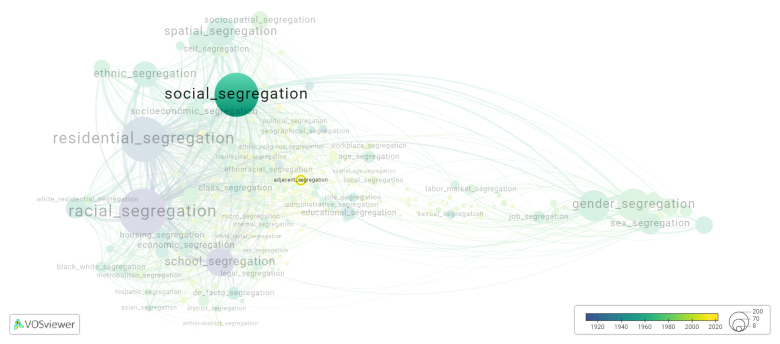Adjacent segregation: Difference between revisions
(Creating page) |
(Creating page) |
||
| (10 intermediate revisions by the same user not shown) | |||
| Line 1: | Line 1: | ||
===== Date and country of first publication<ref>Date and country of first publication as informed by the Scopus database (December 2023).</ref>===== | |||
2019<br> | 2019<br> | ||
China | |||
===== Definition ===== | |||
Adjacent segregation in the context of residential segregation refers to the spatial separation of different racial, ethnic, or socioeconomic groups within close proximity to each other. Unlike more explicit forms of segregation where distinct neighborhoods are completely isolated from each other, adjacent segregation implies that neighborhoods or areas inhabited by different groups are geographically adjacent but remain socially and culturally segregated. | |||
This form of segregation can manifest in several ways: | |||
Block-by-Block Segregation: In some cases, neighborhoods may be racially or socioeconomically homogeneous at the level of individual blocks or streets, with little diversity within each block. However, adjacent blocks may be inhabited by different groups, leading to a checkerboard pattern of segregation. | |||
Gentrification and Displacement: In gentrifying neighborhoods, newcomers of higher socioeconomic status may move into a previously low-income area, resulting in adjacent segregation where new upscale developments coexist with existing lower-income housing. | |||
Subdivision Segregation: Residential developments or subdivisions may be segregated by design, with certain areas allocated for specific racial or socioeconomic groups. In some cases, these subdivisions may be adjacent to each other but remain socially segregated. | |||
Informal Social Boundaries: Even in mixed neighborhoods, informal social boundaries may exist that discourage interaction between different groups, leading to de facto segregation despite physical proximity. | |||
Adjacent segregation can perpetuate social inequalities and limit opportunities for interaction and social cohesion between different groups within a community. It underscores the complexity of residential segregation, which can occur even in settings where physical proximity might suggest integration. | |||
==See also== | ==See also== | ||
==Related segregation forms== | |||
Adjacent segregation is frequently discussed in the literature with the following segregation forms: | |||
[[social segregation]] | |||
[[File:adjacent_segregation.png|780x780px]] | |||
This visualization is based on the study [[Segregation_Wiki:About| The Multidisciplinary Landscape of Segregation Research]]. | |||
For the complete network of interrelated segregation forms, please refer to: | |||
* [https://tinyurl.com/2235lkhw First year of publication] | |||
* [https://tinyurl.com/2d8wg5n3 Louvain clusters] | |||
* [https://tinyurl.com/223udk5r Betweenness centrality] | |||
* [https://tinyurl.com/244d8unz Disciplines in which segregation forms first emerged (Scopus database).] | |||
==References== | ==References== | ||
== | ==Notes== | ||
<references /> | |||
{{NoteAI}} | |||
==Adjacent segregation appears in the following literature== | |||
Zhou X. | Zhou X., Cheng Y. (2019). Between State and Family: Discussion on the Segregation and Integration of the Daily Living Space within Shanghai Historic Lane Neighborhood. ''Home Cultures'', ''16''(3), 163-190. Taylor and Francis Ltd..https://doi.org/10.1080/17406315.2020.1752550 | ||
Latest revision as of 07:17, 16 October 2024
Date and country of first publication[1][edit | edit source]
2019
China
Definition[edit | edit source]
Adjacent segregation in the context of residential segregation refers to the spatial separation of different racial, ethnic, or socioeconomic groups within close proximity to each other. Unlike more explicit forms of segregation where distinct neighborhoods are completely isolated from each other, adjacent segregation implies that neighborhoods or areas inhabited by different groups are geographically adjacent but remain socially and culturally segregated.
This form of segregation can manifest in several ways:
Block-by-Block Segregation: In some cases, neighborhoods may be racially or socioeconomically homogeneous at the level of individual blocks or streets, with little diversity within each block. However, adjacent blocks may be inhabited by different groups, leading to a checkerboard pattern of segregation.
Gentrification and Displacement: In gentrifying neighborhoods, newcomers of higher socioeconomic status may move into a previously low-income area, resulting in adjacent segregation where new upscale developments coexist with existing lower-income housing.
Subdivision Segregation: Residential developments or subdivisions may be segregated by design, with certain areas allocated for specific racial or socioeconomic groups. In some cases, these subdivisions may be adjacent to each other but remain socially segregated.
Informal Social Boundaries: Even in mixed neighborhoods, informal social boundaries may exist that discourage interaction between different groups, leading to de facto segregation despite physical proximity.
Adjacent segregation can perpetuate social inequalities and limit opportunities for interaction and social cohesion between different groups within a community. It underscores the complexity of residential segregation, which can occur even in settings where physical proximity might suggest integration.
See also[edit | edit source]
Related segregation forms[edit | edit source]
Adjacent segregation is frequently discussed in the literature with the following segregation forms:
This visualization is based on the study The Multidisciplinary Landscape of Segregation Research.
For the complete network of interrelated segregation forms, please refer to:
References[edit | edit source]
Notes[edit | edit source]
- ↑ Date and country of first publication as informed by the Scopus database (December 2023).
At its current state, this definition has been generated by a Large Language Model (LLM) so far without review by an independent researcher or a member of the curating team of segregation experts that keep the Segregation Wiki online. While we strive for accuracy, we cannot guarantee its reliability, completeness and timeliness. Please use this content with caution and verify information as needed. Also, feel free to improve on the definition as you see fit, including the use of references and other informational resources. We value your input in enhancing the quality and accuracy of the definitions of segregation forms collectively offered in the Segregation Wiki ©.
Adjacent segregation appears in the following literature[edit | edit source]
Zhou X., Cheng Y. (2019). Between State and Family: Discussion on the Segregation and Integration of the Daily Living Space within Shanghai Historic Lane Neighborhood. Home Cultures, 16(3), 163-190. Taylor and Francis Ltd..https://doi.org/10.1080/17406315.2020.1752550

